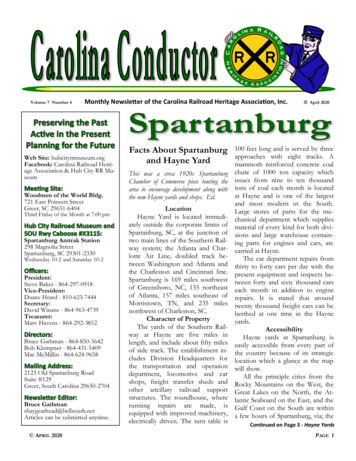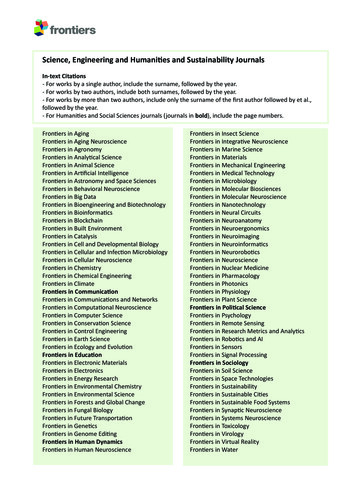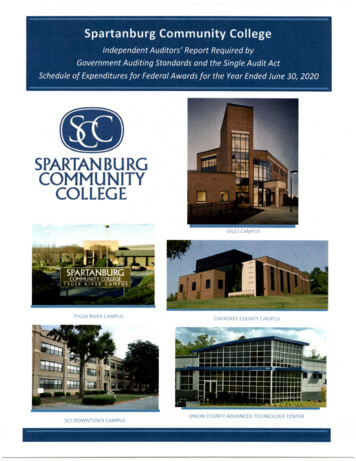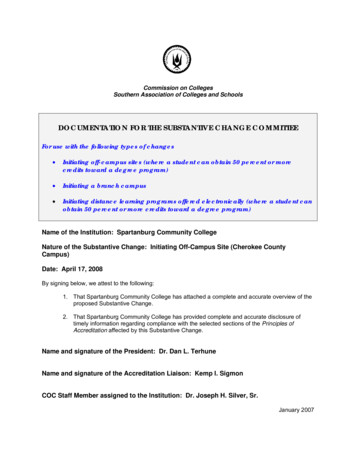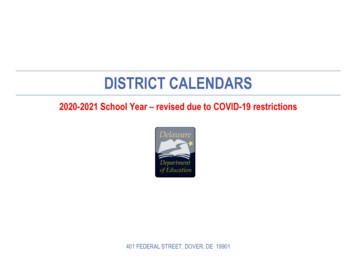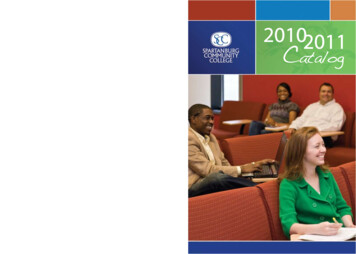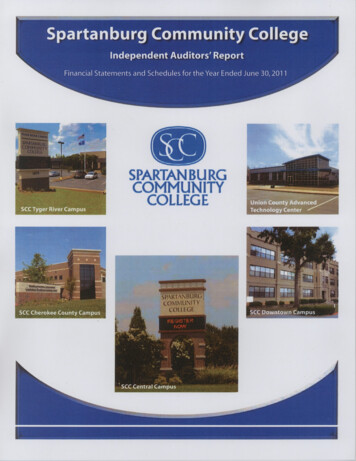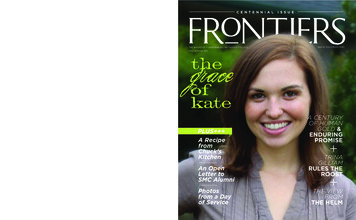
Transcription
C E N T E N N I A LTHE MAGAZINEOFSPARTANBURG METHODIST COLLEGEI S S U ESMCSC. EDU/FR ONTI ER SFaLL/WINTER 2011thegraceofkatecall today for infoPLUS A RecipefromChuck’sKitchenAn OpenLetter toSMC AlumniforPhotosfrom a Dayof ServiceA CENTURYOF HUMANGOLD &ENDURINGPROMISE TRINAGILLIAMRULES THEROOST THE VIEWFROMTHE HELM
is now our Athletic StudentRecruitment and RetentionOfficer. Both will continuecoaching. Given the important role that athletics playin the life of SMC, we arevery fortunate to have Timand Dan helping us in thesenew ways.A PUBLICATION OF SPARTANBURG METHODIST COLLEGE,FALL / WINTER 2011OFFICERS OFSPARTANBURGMETHODISTBoard ofTrusteesMR. JOHN BELL.MS. CAROL BURDETTECOLLEGE.MR. JUSTIN CONVERSEPRESIDENT: DR.DR. ED ELLIS.COLLEEN PERRYDR. PHINNIZE FISHER.KEITHMR. JOHN GRAMLING.MRS. MARIANNAHABISREUTINGER.VICE PRESIDENTMR. STEVEN HAHN.FOR ACADEMICMR. MARK HAMMOND.AFFAIRS: DR. ANITAREV. LARRY HAYS.MR. PAT HENRYK. BOWLES.REV. MITCH HOUSTON.MR. RAY LATTIMORE.VICE PRESIDENT FORMANAGEMENT:REV. WILL MALAMBRI.REV. JEAN OSBORNE.MR. BILL PAINTERDANIEL L. PHILBECK.MRS. LIZ PATTERSON.MR. JOHN RAMSEY.VICE PRESIDENT FORMRS. PATSY SIMMONS.BUSINESS AFFAIRS:ERIC MCDONALDMR. GUY SPRIGGSOF INSTITUTIONALI hope you can feel theexcitement as we enter our101st year! This fall, we notonly welcomed 803 newand returning students tocampus, but also three newfaculty members: Dr. LannyLanford (music), Dr. Benjamin Sloop (math), and Dr.Cyril Kendrick (sociology).MR. JIM THOMPSON.StudentAdvisory Trustee:We also have some familiarfaces in new roles: two ofour award-winning (and justplain winning!) coaches. TimWallace is our new AthleticDirector, and Dan KenneallyPAULIA HUGHESDEVELOPMENT:EDITOR IN CHIEF: CLARE BALLCREATIVE DIRECTOR: CHRIS BRANTLYART DIRECTOR: DEREK WETTERBOB FUZYI hope you will visit thecampus to see thesechanges and consider a giftto help us. Your participationin our campaign, Pioneeringthe Future: The CentennialCampaign for SpartanburgMethodist College, will helpto ensure that we canadequately attend to ourphysical needs (as well asour scholarship needs).We ask that you continue tohold us close in prayer, andwe invite you to comecelebrate with us!Blessings and Peace,.REV. LILLIANWASHINGTONVICE PRESIDENTwhole atmosphere is one ofhope and thrill, and something I look forward to everyyear. It’s a wonderful time tobe an SMC Pioneer!DR. FRANK LEE.ENROLLMENTThe entirecampus is fullof fresh energy;students areenthusiastic andnervous at thesame time, andfaculty and staffseem to havean extra bouncein their step. TheConstruction for a newacademic building (the firstin over 40 years) alsobegins as we celebrate ourCentennial. It will housecourses and faculty for Arts,Music, Drama, Humanities,Social Science, English, andReligion. This will allow us tomove offices and peoplefrom other areas of campusinto renovated spaces freedup by the new building.CONTRIBUTING WRITER: KATHY CANNColleen Perry Keith, Ph.D.PresidentP.S. Look for a specialfeature on our awesomeathletic program in ourSpring Frontiers! In themeantime, let us know ifyou'd like a copy of ourPioneer Athletic magazine.CoNTENTS
CoNTENTS19Features.511131519A Century of Human GoldSMC’s esteemed historian Dr. Kathy Cannshowcases the school’s ornate historyin her celebratory centennial article.God Loves Right Notes NewDirector of Music Lanny Lanford talksmusic, his background, and his bigplans for SMC.Ruling the Roost Trina Gilliamsets the bar for student conduct fromher new position as Director of ConflictResolution.The View from the HelmOfficial student photographer Tayler Helmsdishes on life as an SMC freshman andshares a few of her award-winning shots.The Grace of Kate Cover girlKate Newman has been affectionatelylabeled the face of SMC. Here, shediscusses her mega-watt involvementon campus, her future plans, and herrecent life-changing trip to Ethiopia.////////////////////////////2122Serving Spartanburg. TheFreshman Day of Service kick-startedthe Fall 2011 semester, setting the tonefor a service-driven year at SMC.Wonder Woman SMC AlumKelly Cauble was named the 2010 SunNews Rod & Harold McCown Woman ofthe Year! Read about her extraordinaryaccomplishments.23A Funny Thing Happenedon the Way to the SymposiumCole Cheek succeeds in giving SMC amajor mental jolt with his push to getthe campus more involved with theUpstate Research Symposium.252729Convocation In honor of SMC’sCentennial, a special convocation was held,followed by a ceremonial ground-breakingand name announcement of the newbuilding on campus.Announcements Alumniupdates.From Chuck’s Kitchen TryChuck the Pioneer’s beef stew! Perfectfor fall.1525
NOV 19, 2011Class Reunions, Basketball,and Low Country Boil10:00 amRegistration, Burgess Student Center10:00 amCoffee with Faculty & Staff, Judd Cellar Coffee Shop11:00 amAlumni Awards Luncheon, Fireplace Room in Burgess Student Center1:30 pmClass Reunions, Judd Lawn2:00 pmAthletic Hall of Honor Revealing & Orlando Hudson Recognition, Sparrow Plaza4:00 pmMens Basketball Game, Camak6:00 pmLow Country Boil, Live Music & Dance, Burgess Student Center Back LawnAlumni Weekend Registration:Name:Class ofSpouse’s Name:Alumnus? ( ) Yes Class of( ) NoAddress:City / State / Zip:Phone (H / M):Phone (W):I will attend the Complimentary Coffee & Muffins withI will attend the Alumni Awards Luncheon withemail:guest(s)guest(s) ( 15.00 per person)(at a charge of 15.00 per person.)V isaMasterCardDiscover for Card #I will attend the Low Country Boil Dinner withCall me at the following number (Bill my)guest(s) ( 10.00 per person)Expiration datefor my payment optionsYou may use the enclosed envelope to return this form to: SMC Office of Alumni Relations, 1000 Powell Mill Road, Spartanburg, SC 29301 or email alumni@smcsc.edu
PRUITTGreetings Alumni,I am so excited to announce and invite you to the largest Alumni Event of2011 Centennial Alumni Weekend, November 18 – 19. To celebrate the 100thyear of SMC, we are inviting alumni, students, parents, faculty and staff to bea part of this thrilling weekend, “SMCside: Treasure the Memories” (as inSMC Seaside). This is the first time we’ve had a combined event and invitedthe entire campus community to participate. I encourage you to come enjoythe fun, family-friendly festivities, including our traditional Alumni AwardsLuncheon and a special beach-themed evening with live beach music andspecial coastal cuisine, but most importantly I encourage you to attend soyou can reconnect with your classmates and reminisce on your time here atSpartanburg Methodist College. Please see the Centennial Alumni Weekendad in this issue of Frontiers for a detailed schedule of events, pricing and theRSVP slip to secure YOUR spot.With the Fall Semester under way, it’s been wonderful to see the positivechanges that our students are experiencing here at SMC that help themprepare for their future endeavors. To elevate their progress, I ask that youconsider contributing to the Alumni Loyalty Fund before December 31, 2011.Your Alumni gift will enhance future opportunities for students to expandtheir academic abilities. Your commitment will help prepare our students tobecome future leaders.Thank you for your consideration of my request. I hope to see YOU atCentennial Alumni Weekend, November 18 - 19.Best Wishes,Leah L. Pruitt ’98Director of Alumni RelationsP.S. Please become a fan of the SMC Alumni page on Facebook to keep upto date with Alumni gatherings and happenings.FRONTIERS / 03
FRONTIERS / 05
a Centuryof HumanGold &EnduringPromiseSeptember, 1911, was a time of expectation and anticipation inSpartanburg. Plans for an interurban transportation system werefinally underway in the city, “the best town of them all.” Residentslooked forward to construction of modern office buildings. Soon,the luxurious Grove Park Inn in Asheville, North Carolina, a populardestination for Spartanburg travelers, would open. And on September 5, David English Camak stood on the porch of a mill houseat the corner of Farley and Brawley Streets in Spartan Mill Village towelcome students to his newly established school. Called TextileIndustrial Institute, the school was the fulfillment of Camak’s dreamto serve the educational needs of men and women who worked inthe city’s textile mills.Katherine D. Cann, Professor of HistoryFRONTIERS / 06
As a student preparing for the ministry atWofford College, English Camak becamedisturbed by what he called “the cottonmill problem,” and set out to find a solutionfor it. The problem Camak identified was agrowing number of illiterate adult farmersmoving to the textile towns of upstateSouth Carolina. Their ignorance, thoughtCamak, made them easily duped bycorrupt politicians and manipulative millowners. He feared the problem would onlygrow worse unless some way to educatethe textile population and prepare them forgood citizenship was found. Inspired byChristian idealism, the Social Gospelmovement, and the emerging Progressivespirit, Camak set out to “find, train, andChristianize. . .men and women to help dothe thinking for the five hundred thousandcotton mill operatives of the South.”TEXTILE INDUSTRIAL INSTITUTECamak understood that lack of moneywas a significant obstacle to adult textileworkers seeking an education. Heproposed a program that would enabletextile workers to attend school and workat the same time. In 1911, with financialbacking and moral support from the mostimportant Spartanburg textile executives,Textile Industrial Institute opened in aborrowed house in Spartan Mill Village,across the street from Duncan MemorialMethodist Church. Camak was disappointed when only one student, a 33-year-old man, showed up on opening day, buthe refused to abandon his dream.By the end of the year, over forty studentshad enrolled. During the next year, morethan two hundred men and women attendedTextile Industrial Institute (TII), and theBoard of Missions of the Methodist EpiscopalChurch, South, adopted TII as a project.From the beginning, there was a strongFRONTIERS / 07emphasis on the liberal arts, becauseCamak believed that “cultural, inspirational,and altruistic elements . . . are the chiefcomponents of right leadership andeffective citizenship.”The modest building on Farley Street inSpartan Mill Village provided by Walter S.Montgomery did not deter students, andTII began to grow. By 1913, the school hadexpanded to a complex of three houses.The facilities might have been somewhatshabby, but the students continued to seeTII as their best hope for the future.HAMMOND HALLThe growth of the student body pointedup the need for a permanent site. In 1913,on donated land, TII students builtHammond Hall, named for one of theschool’s earliest and most ardent supporters, Charles P. Hammond. The quarry atPacolet donated the granite used for thebuilding, and the Southern Railway carriedit, free of charge, to the site. For a time,Hammond, the only building on campus,housed male and female dormitories, thelibrary, dining hall, classrooms, offices, andthe president’s residence. After World WarI, enrollment increased dramatically, asreturning veterans, many of them married,entered TII. School officials coped with theinflux by erecting tents, acquired from theArmy as it was dismantling Camp Wadsworth, a training camp adjacent to thecampus.The work program was critical to theschool. The student body was divided intotwo sections. Each student had a partner,and they shared a job, working one weekand going to school one week. Thus, everystudent worked half time. At first, thestudents worked at Arcadia and SaxonMills, within walking distance of the
CENTURYcampus. As the enrollment grew, studentsfrom rural areas also sought admission. Forthose with no textile experience or thosewith physical problems that precluded millwork, TII located other types of jobs onand off campus. Students also worked forthe school in offices, in the dining hall, andon the school-owned dairy and farm.CHARACTER CLOTHCamak had always hoped to build aninstitute-owned mill to provide work forthe students and additional income for theschool. In 1919, with money borrowed fromPresident Camak, and in 1923, he resigned.The Board of Trustees quickly appointedRembert Burgess, who had been a TIIemployee since 1915, as his successor. TheBoard of Trustees was determined to payoff all obligations, a total of over 260,000.It was also committed to keeping the school,which continued to attract students, open. In1925, the Board of Missions of the MethodistEpiscopal Church, South, acquired TII underits Home Department in cooperation with theSouth Carolina Methodist Conferences. PowellKnitting Company of Philadelphia, Pennsylvania, purchased the Model Mill in 1927.Camak was disappointed when only one student, a33-year-old man, showed up on opening day, but herefused to abandon his dream.local textile firms and banks, TIIconstructed the Model Mill, a kind of textilelaboratory that enabled student workers tolearn every step of the textile process.Eventually, the mill produced a gingham-typefabric called “Character Cloth” because of“its superior quality and its association withthe character-building in the students whomade it.”Unfortunately, the mill failed due to aprecipitous decline in the cotton market, anincompetent overseer, a plant too smalland too varied to be profitable, andCamak’s inexperience with the industry.The school’s assets were inextricably tiedto the fortunes of the Model Mill, and in theearly 1920s, school officials and supportersfrantically tried to save both. Their efforts,however, did not halt the collapse of theModel Mill.REMBERT BURGESSFinancial pressures and the stress ofoperating the mill took their toll onThe equipment was sold separately. Thetwo South Carolina Methodist Conferencespledged to raise funds to help pay off theremaining debt, and they did.Responding to students’ requests, in 1927,Textile Industrial Institute added two yearsof college-level work to the curriculum,attracting traditional college-age students.In 1931, the South Carolina State Board ofEducation accredited TII as a junior college,and the school joined the AmericanAssociation of Junior Colleges, giving it astature it had not previously had andstimulating the administration to work toimprove standards at all levels.TII began to experience the impact of theGreat Depression in 1930 when manySpartanburg textile mills curtailed operations, leaving half of local textile workersunemployed and few positions availablefor student workers. The school admittedmore students from rural areas andaccepted produce from their family farmFRONTIERS / 08
for tuition. By 1936, the school was at fullcapacity.SPARTANBURG JUNIOR COLLEGEIn the mid-1930s, in the midst of a nationaleconomic crisis, TII began to expand itsfaculty, curriculum, facilities, and studentemployment opportunities. In addition toliberal arts, the curriculum included homeeconomics, commercial science, secretarialprograms, and teacher training. All degreesand programs required a heavy componentof liberal arts – English, history, math andscience, and of course, Bible. The construction of Walker Hall and the Moore StudentActivities Building during the 1930s reliedon student labor and donated materials.The college eliminated the high schoolcurriculum in 1939 and changed its namethree years later to reflect its new statuswhen the Board of Trustees adopted thename Spartanburg Junior College. In 1957,the Southern Association of Colleges andSchools, the accrediting agency for allSouth Carolina colleges, admitted Spartanburg Junior College to membership, andthe following year, the University Senate ofthe Methodist Church did the same.In 1962, Spartanburg Junior College (SJC)began an association with the Board ofMissions of the South Carolina MethodistConference.that “no worthy boy or girl, man or woman,shall be turned away for lack of money.” Inkeeping with its missionary heritage, SJCwas in the vanguard of racial integrationand admitted the first African Americanstudents in 1966. But perhaps Kingman’sgreatest achievement was a major expansion of the physical plant that included twodormitories, a science building and astudent center.JAMES BARRETTUpon Kingman’s retirement in 1969, theBoard of Trustees chose James Barrett asthe institution’s fourth president. In the1970s, two developments influenced thecourse that SJC would follow: the availability of large sums of federal money to fundinnovative programs, and the emergenceof a technical school system in SouthCarolina. To compete with the technicalschools and make the best use of federalfunds, Spartanburg Junior College implemented a number of curricular innovations,offering not only liberal arts but also careerprograms not available at SpartanburgTechnical College or the newly establisheduniversity branch on the outskirts of town. Generous federal financial aid, coupledwith the innovative curriculum and scheduling, spurred the growth of the studentbody.SPARTANBURG METHODIST COLLEGEH. LESTER KINGMANUpon President Burgess’ sudden death in1962, the Board selected H. Lester Kingmanas his successor. Kingman oversaw the endof the old “week about” work system; thecollege no longer required work or guaranteed jobs to students. Spartanburg JuniorCollege adopted a more selective admissions policy. However, the college pledgedFRONTIERS / 09By 1974, many members of the Boardbelieved that the word “Junior” in thecollege’s name hampered fund-raisingefforts, and at the request of a group ofstudents, changed the name to Spartanburg Methodist College, an acknowledgement of the college’s historic connectionboth to the Methodist Church and theSpartanburg community.
CENTURYGEORGE D. FIELDS, JR.COLLEEN PERRY KEITHThe college’s fifth president, George D.Fields, Jr., assumed the position in 1975,directing improvements in the college’sathletic facilities and construction of a newgymnasium/auditorium/ classroom building. The college continued to search forunique academic programs, includinginterpretation for the deaf, retail merchandising and marketing, and banking. Theevening classes blossomed into NewCollege, a separate division of SJCdesigned especially for “non-traditional,more mature students who work incareers or have other responsibilities. . .”Changes in South Carolina’s demographicsand educational environment promptedSMC to consider offering bachelor’sdegrees, a change that would radicallyalter the college’s character and perhapsits mission. After a careful examination ofthe data, a committee concluded in 1991that remaining a viable two-year collegebest served the college’s mission andinterests.The expansion of facilities and theacademic program continue underSpartanburg Methodist College’s currentpresident, Dr. Colleen Perry Keith, whocame to Spartanburg Methodist from Ohio,where she had once been on the staff ofthe Methodist Theological School in Ohio.Since Keith’s arrival, the college has addednew associate degrees in religion, fine arts,and business, and a revamped professionaldevelopment office. On September 6, 2011,in conjunction with the college’s 100thanniversary, board members, friends of thecollege, and SMC representatives brokeground on Edgar H. Ellis, Jr. Hall, the firstnew academic building since the 1970s.Editor's Note: Also during Fields' time atSMC, Parson's Residence Hall and DavisChapel were constructed.Though the student population todayconsists almost entirely of traditionalcollege-age students, SMC continues toprovide opportunity for students of limitedmeans. It continues to embrace Camak’svision of an educational partnership throughits campus service and Work Study programs.At the same time, Spartanburg MethodistCollege is committed to providing itsstudents with all the tools needed to livewell in the twenty-first century. CHARLES PORTER TEAGUE, JR.The Spartanburg Methodist College Boardof Trustees selected an outside firm tocoordinate the presidential search afterGeorge Fields announced his retirement in1996. The board unanimously named CharlesPorter Teague, Jr., academic dean atBrevard College and a Methodist minister,as the college’s sixth president. DuringPresident Teague’s 13-year tenure, thecollege facilities expanded, including twonew residence halls, the Vassey TechnologyCenter, and the Buchheit Board Room.Perhaps more significantly, the collegestrengthened its academic program andsecured re-accreditation from SACS.FRONTIERS / 10
“God loves right notes,” Dr. Lanny LanfordMethodist churches in the Upstate area; assays with a laugh. And when it comes toLanford says, “Their purpose is multi-fold.right notes, Lanford is pitch-perfect.Since the Methodist church, as a whole,In addition to a full course load and direct-supports our school, this is a way to thanking the SMC Singers, Dr. Lanford has alsothem. And, of course, they represent ourrevitalized the SMC Troubadours, a travelingschool.” For the performances, he expectsselect choral group.his students to be dressed sharply and toexhibit consistency in professionalism –Students involved in the Troubadoursmeaning, each song will be memorized, andreceive scholarship assistance, and theythe group will remain the same through thealready have a hefty schedule for their firstcourse of the year to achieve a really gelledsemester together. The Troubadours willsound.perform a variety of music, primarily inFRONTIERS / 11
That’s not all Lanford has on his plate. He’sLanford’s compositions have receivedgot an aggressive approach to building theworld-wide attention; his most notablemusic program, his primary goal being toaccolade was winning the Internationaldouble student involvement within the nextComposition Competition for his piece,two years. “Right now, we have thirtyLes Chevaliers du Tastevin. Written in bothstudents; next year, I want to have over 40,French and English, this piece is particularlyand the year after that, I expect 60-plus,” heremarkable in that it was completed in justsays confidently. Lanford proclaims he wasfive days.THE NEW DIRECTOR OF THE SMCMUSIC PROGRAM ALREADY HASBIG PLANS IN THE WORKS FORHIS FIRST YEAR ON THE JOBpleasantly surprised by the caliber of vocalAnother project that garnered majortalent at SMC. “My expectations wereattention for Lanford was his original scoreexceeded,” he says, his energy palpable,for the feature film, More Than Diamonds,and it’s easy to see that he’ll be pushing fullwhich he wrote, performed, and recorded.steam ahead with the music department.Released in September of 2010, this filmquickly led to Lanford’s current involvementLanford hails from Greenville, Southin writing and music groups across theCarolina, and holds a bachelor’s degree incountry, from South Carolina to California.music education (with a choral emphasis)from the University of South Carolina. HeLanford continues to pursue any opportu-earned a master of church music degree innity to write and record original music, be ittheory and composition from the Southernfor a movie, a play, or just himself. HisBaptist Theological Seminary in Louisville,relentless hard work and esteemed leadershipKentucky. He returned to the University ofskills make him the perfect addition to theSouth Carolina to complete his Doctorate ofSMC team. Musical Arts in Composition.FRONTIERS / 12
when it comes to settling ruffled feathers,TRINA GILLIAMResidence Life is one tough branch tomanage – building maintenance, roommatesquabbles, student safety. Still, it’s abranch that Trina Gilliam was drawn to,and one she’ll never shy away from.She was recently promoted to Directorof Conflict Resolution and Ethics, whichmeans, that while she’s still a majorplayer in the Residence Life field, she’llbe less involved with specific residencehall politics and more invested incampus-wide conflicts. It’s a pretty bigposition to take over, and is magnified bythe fact that this is the first year SMC hasever staffed this position. “It’s a bigchange,” Gilliam says, nodding.When walking into Trina Gilliam’soffice, one of the first items tocome into view is an unusualaward: a bear statue on her bookshelf. “It’s a trophy,” she insists,laughing. The former AssistantDirector of Residence Life, Gilliampassed the bear around eachmonth – it was awarded to thestudent Resident Assistant oradult Residence Life staff memberwho made the semester the most“bearable.”Gilliam has long been a fixture at SMC.Ten years ago, she started working inthe Business Office. While there, sheheard about an opening as a ResidenceHall Director, and pursued it. Over thenext few years, she served as thedirector for several campus residencehalls, and became Assistant Director ofResidence Life. Also on campus, she hasserved on the Staff Council Committee,the Quality Enhancement Plan (QEP)Committee, and the Retention Committee. She’s been recognized as a studentmentor, and earned the J.L. Geddis StaffExcellence Award in 2009 – all whilepursuing her master’s degree in educational counseling from Clemson andFRONTIERS / 13
GILLIAMwhen it comes to settling ruffled feathers,participating in the Army Reserves.Though her work ethic is magnanimous,Gilliam’s not one to brag. “Working heremakes you feel like you’re part of afamily,” she says. “Everyone supportseach other. SMC has been good to me;amazing people have helped me alongthe way.”Beyond gaining immense respect fromher colleagues, Gilliam has an excellentrapport with students, and is quick todiscuss how much she enjoys workingdirectly with students. “As a hall director, you can work one-on-one withstudents going through something, andsoothing student blow-ups. “Over theyears, students have sent me the mostthoughtful letters, thanking me for myhelp. I still have all their letters; they remindme that I can really get them to think.“I’ve been in this job from the ground up,and it’s been an amazing journey,” shecontinues with a nod. A hard-workingwoman with a big heart to boot, TrinaGilliam is a prized asset in the SMCcommunity, and she’ll shine an even greaterlight on campus with her new position.they open up to you more.” She’s set onretaining that sense of closeness withstudents in her new position. “Idefinitely don’t want to be Judge Judy!”she says, laughing. “The students keepme young. I just want them to succeed,and not get wrapped up in the trivialthings. I want the best for all of them.”As the Director of Conflict Resolutionand Ethics, Gilliam will overseeprograms geared toward conflictStudents hone their computerskills under Trina Gilliam’swing as she oversees SMC’syearbook production.resolution on campus. This means she’llhandle all student conduct cases, aswell as working with groups of studentsto smooth out personal conflicts. As sherecounts her experiences as a HallDirector, it’s clear she’s no stranger toFRONTIERS / 14
THEVIEW.from .THEHELMFRONTIERS / 15.
Colleen Perry Keith, Ph.D. President P.S. Look for a special feature on our awesome athletic program in our Spring Frontiers! In the meantime, let us know if you'd like a copy of our Pioneer Athletic magazine. Board of Trustees MR. JOHN BELL MS. CAROL BURDETTE MR. JUSTIN CONVERSE DR. ED ELLIS DR. PHINNIZE FISHER MR. JOHN GRAMLING MRS. MARIANNA .
